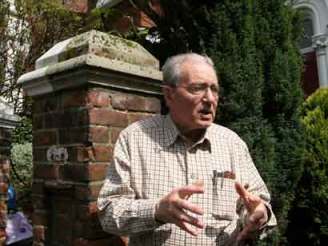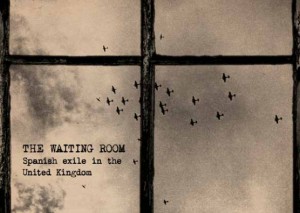The Waiting Room: Spanish Exile in the United Kingdom – The Waiting Room: el exilio español en el Reino Unido
The Waiting Room es una exposición sobre la realidad de la posguerra civil española en los ojos de los exiliados en el Reino Unido entre 1940 y 1978. Entre ellos hubo varias figuras literarias, que inmortalizaron el sentimiento de una nación; una nación alejada de su patria, que vivió esta época con los ojos puestos en el calendario.
The Waiting Room es un proyecto de IC Communication en colaboración con el Instituto Cervantes. Además de la exposición de material literario y fotográfico, hay varias actuaciones en el marco de The WaitingRoom, que ayudan a contextualizar el momento histórico del país y su significado en la actualidad. Las fechas y horarios se pueden consultar en el programa de actividades culturales de junio.
La exposición está abierta al público en nuestro centro (102 Eaton Square, London SW1W 9AN) hasta el 30 de junio de 2015.
___________________________________________________
The WaitingRoom is an exhibition about the Spanish Civil War aftermath through the eyes of those exiled in the United Kingdom between 1940 and 1978. Among them, there were several literary figures, who captured the feeling of a nation; a nation far from its roots, that spend the better part of this era looking at the calendar.
The Waiting Room is a project by IC Communication in collaboration with Instituto Cervantes. In addition to the exhibition of literary and photographic material, there are several events on the topic of The Waiting Room, which help put this historic event and its current meaning into context. Dates and times can be found in our June cultural programme.
The exhibition is open to the public at our centre (102 Eaton Square, London SW1W 9AN) until 30 June 2015.
The Waiting Room. El exilio español en el Reino Unido – The Waiting Room. Spanish exile in the United Kingdom
Muchos exiliados españoles llegaron al Reino Unido en la primera mitad del siglo XX. Atrapados entre dos guerras, percibieron su propio traslado como algo temporal, aunque para algunos se convirtiera en permanente.
Este proyecto repasa la contribución intelectual de los que llegaron a este país, y presenta su historia como parte intrínseca de la historia de Gran Bretaña. ¿Sería posible, a día de hoy, concebir la idea del exilio fuera del contexto de condición forzosa? ¿Podría esa reformulación dar pie a una nueva realidad, en la que ciudadanos globales cruzasen fronteras e interactuasen con otras culturas con normalidad?
The Waiting Room, a lo largo de dos meses de música, cine, literatura, documentales, charlas y arte, intenta profundizar en estas cuestiones vitales sobre el exilio, la memoria y la identidad, culminadas en una ciudad tan extraordinaria como Londres.
The Waiting Room es una exhibición gratuita, abierta del 27 de abril al 30 de junio de 2015 en nuestro centro en 102 Eaton Square, London SW1W 9AN.
______________________________________________________________
Spanish exiles arrived in the UK in the first part of the XX century. Trapped between two wars, their presence was a period of transition that, for some, became permanent.
This project serves to introduce a dialogue about the intellectual contribution of those who came to this country, and to present their story as part of the very history of the UK. Would it be possible today to rethink the notion of exile beyond its typical association of being a forced condition? Could that formulation give place to the creation of a new outcome, a global citizen able to transit among borders and cultures?
The Waiting Room, through two months of music, cinema, book, documentary, talks and art, intends to explore these vital questions around exile, memory and identity, highlighted by a city as extraordinary as London.
The Waiting Room is an open and free exhibition, taking place on 27 April through 30 June 2015 in our centre on 102 Eaton Square, London SW1W 9AN.
Ciclo de conferencias: Entre escritoras 1 & 2
Lecture Series: Among female writers 1 & 2
1. A propósito de Carmen Martín Gaite. JUE 5 MAYO / THU 5 MAY
2. De Esther Tusquets a Ana María Matute. VIE 6 MAYO / FRI 6 MAY
Carmen Laforet, Carmen Martín Gaite y Ana María Matute, tres escritoras españolas relevantes depostguerra, no sólo tuvieron que sufrir la censura propia de esos años; como mujeres, también tuvieron que superar muchos obstáculos para alcanzar el reconocimientio de crítica y público. Las tres recibieron el Premio Nadal por su primera novela: Carmen Laforet con Nada (1944); Carmen Martín Gaite con Entre visillos y Ana María Matute con Primera memoria (1959) /

The three outstanding writers of post-war Spain, who not only had to suffer the censorship typical of the time, but also -as women- overcome many obstacles to gain the recognition of readers and critics. All three received
the Premio Nadal for their first novels: Carmen Laforet’s Nada (1944); Carmen Martín Gaite’s Entre Visillos (1957) and Ana María Matute’s Primera memoria (1959).
La primera de las conferencias será impartida por la escritora Laura Freixas. / The first lecture will be given by the writer Laura Freixas.
Para la segunda sesión, contamos con la presencia de otra gran figura literaria, Esther Tusquets que hablará sobre su gran amiga Ana María Matute, Premio Cervantes 2010. / For the second session, we will be joined by another prominent literary figure Esther Tusquets, who will talk about her great friend Ana María Matute, winner of the Premio Cervantes 2010.
Ambas presentadas por / Both presented by María José Blanco (IGRS, School of Advanced Study, University of London).
6.30pm. Institute of Germanic & Romance Studies, University of London, Stewart House ST274/275, 32 Russel Square, London, WC1B 5DN
Ciclo de conferencias: Entre escritoras 1
Entre escritoras 1: De Esther Tusquets a Ana María Matute.
Carmen Laforet, Carmen Martín Gaite y Ana María Matute, tres escritoras españolas relevantes de postguerra, no sólo tuvieron que sufrir la censura propia de esos años; como mujeres, también tuvieron que superar muchos obstáculos para alcanzar el reconocimiento de crítica y público. Las tres recibieron el Premio Nadal por su primera novela:
Carmen Laforet con Nada (1944);
Carmen Martín Gaite con Entre Visillos (1957);
Ana María Matute con Primera memoria (1959).
Para empezar este homenaje contamos con la presencia de otra gran figura literaria Esther Tusquets que hablará sobre su gran amiga Ana María Matute, Premio Cervantes 2010.
Presentado por María José Blanco (IGRS, School of Advanced Study, University of London).
Lunes 7 de Marzo.
6.30pm. Chancellor’s Hall, Senate House (University of London) – Malet St.City of LONDON WC1E7HU
Javier Cercas meets the BBC’s World Book Club.
 Today an interview with one of Spain’s leading authors took place in front of an audience at the Instituto Cervantes London. Javier Cercas is a novelist, short-story writer and essayist, whose books include El móvil and Relatos reales. His novel Soldados de Salamina has sold more than 500.000 copies in Spain and has been publisehd in more than fifteen languages, to great acclaim in France, Germany and Italy. Cercas is a regular contributor to the Catalan edition of El País.
Today an interview with one of Spain’s leading authors took place in front of an audience at the Instituto Cervantes London. Javier Cercas is a novelist, short-story writer and essayist, whose books include El móvil and Relatos reales. His novel Soldados de Salamina has sold more than 500.000 copies in Spain and has been publisehd in more than fifteen languages, to great acclaim in France, Germany and Italy. Cercas is a regular contributor to the Catalan edition of El País.
Javier Cercas is also going to be on Southbank at 7.45pm to present his latest book to be translated into English, Anatomy of a moment.
For details see: www.southbankcentre.co.uk
Young people should know about history
 CHILDREN’s eyes record images that adults can’t see, enriching our understanding of history. Herminio Martínez was one of the young Basque children who in 1937 arrived in England after fleeing from the Spanish civil war. Their eyes saw everything. Now Herminio has recalled the story of his childhood, a story shared by many others who left Spain and came to Britain in search of a home.
CHILDREN’s eyes record images that adults can’t see, enriching our understanding of history. Herminio Martínez was one of the young Basque children who in 1937 arrived in England after fleeing from the Spanish civil war. Their eyes saw everything. Now Herminio has recalled the story of his childhood, a story shared by many others who left Spain and came to Britain in search of a home.
“I live near Highgate cemetery. Do you know where it is? And do you know who is buried there?” This was how Herminio gave me directions when we arranged our interview, and his cosy flat is indeed just a stone’s throw from where Karl Marx lies.
Herminio was one of the 4,000 children who on May 21 1937 boarded a ship to set sail for Southampton. “It was a terrible crossing. We were 4,000 children in a ship for 400 passengers. I was seven and my brother 11. We slept on the floor. We ran into a storm in the Bay of Biscay and that was a horrifying situation, rolling on the floor, throwing up, and many kids crying out to go back to Bilbao with their parents…”




